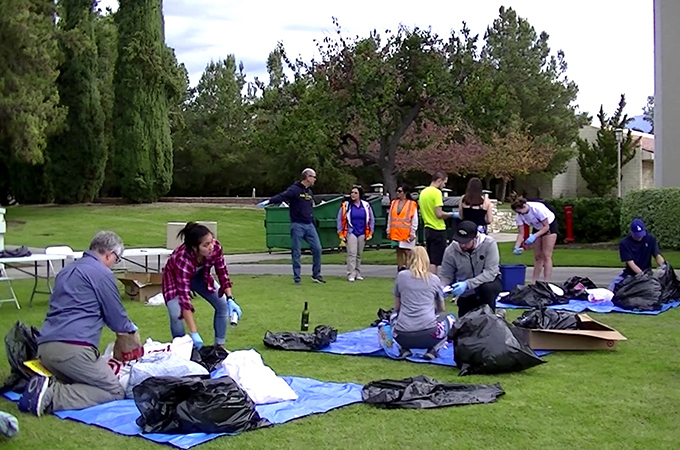On November 11, I held a “Dumpster Dive” on the Freshman Lawn at University of Redlands’ main campus. I am a new, visiting assistant professor, specializing in sustainable business and applied ethics. Students from my Sustainable Cities and Intro to Sustainable Business classes participated, but the event had an even greater turnout. Four additional faculty members and 38 students helped sort the recyclable and compostable materials from the nonrecoverable materials, which would be forced to go to landfill. The experiential learning activity brought us new insights about the magnitude of waste on campus and our individual contributions to managing it properly—and the odor was not enough to take the smiles from our faces.
With the support of the Facilities Maintenance and Operations staff, we used a representative sample of five of the 50 garbage dumpsters from across the campus. Beyond the 50 “garbage” dumpsters, there are dumpsters designated for recycling and bins for state-mandated compostable materials at the Commons.
During the event, the volunteers sorted 114 bags. We finished with 79 bags of trash, 16 of papers, 13 of plastics (11 of hard plastic containers, 2 of soft plastic films), 3 bags of compostable materials, 2 bags of metals (such as aluminum and steel cans), and 1 bag of glass bottles. Once sorted, the materials were placed into their proper bins.
These results suggest a 70% success rate for placing garbage in the proper bin, and a 30% error rate related to incorrect disposal of recyclable or compostable material. When I asked students about their reactions, many students expressed their shock at the amount of garbage produced, but they were divided about whether the rates of sorting matched their expectations. Some told me they expected higher success; others anticipated lower success. Some additional surprises included a pair of computer keyboards, maggots, unopened beverages and boxes of food, half a dozen pairs of underwear, pillows, and a wooden toothbrush.
From this data, I calculated some preliminary estimates of campus-wide waste from the garbage-designated dumpsters. However, they should be taken with a grain of salt, considering the sampling techniques. I first took into account that one-third of each dumpster was not sorted, and then extrapolated the composition portions to the campus scale, for a rough approximation. This suggests as many as 1,740 bags are placed in the garbage-designated dumpsters on any given day. Those could include 1,200 bags of trash, 250 bags of paper, 200 bags of plastics (170 hard, 30 soft), 45 bags of compost, 30 bags of metals, and 15 bags of glass bottles—which does not include the recycle-designated dumpsters and compost bins.
Although I had conducted a similar event at a previous campus, in some ways I was surprised at the waste composition. The breakdown matches similar proportions of materials I found at the previous campus, but does not conform to proportions within a statewide evaluation. The California Waste Characterization (2014) estimated the state’s waste as approximately 37% organics, 20% construction materials, 17% papers, 10% plastics, 5% “special wastes” (which includes furniture and multi-material larger goods), and 3% or less of metals, glass, and others. I assume that the University’s lower-than-expected fraction of compostable materials is attributable to the University’s excellent work composting materials from the Commons, diverting it from the landfill.
I want to extend great thanks to the Facilities Maintenance and Operations staff, Sustainability Council, Environmental Studies Department, University Greek Life, Students for Environmental Action, Black Student Union, and SURF Garden for making this event a success, and for the City of Redlands and CR&R Wastes for lending their support.
I wish to encourage students wanting to make a bigger impact on the campus or the city to contact me with ideas for more extracurricular opportunities.
Learn more about Environmental Studies at the University of Redlands.






